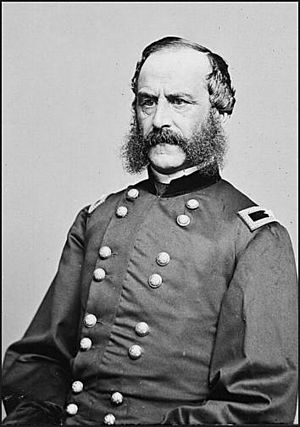Gustavus De Russy facts for kids
Quick facts for kids
Gustavus De Russy
|
|
|---|---|
 |
|
| Quartermaster of Fort Monroe | |
| In office 1848–1857 |
|
| Personal details | |
| Born | November 3, 1818 Brooklyn, New York, U.S. |
| Died | May 29, 1891 (aged 72) Detroit, Michigan, U.S. |
| Spouse |
Frances Clitz
( |
| Parents | René Edward De Russy Harriet Elizabeth Taylor |
| Education | West Point |
| Military service | |
| Allegiance | United States of America |
| Branch/service | United States Army Union Army |
| Rank | |
| Commands | III Corps |
| Battles/wars | Mexican–American War: • Battle of Contreras • Battle of Churubusco • Battle of Chapultepec U.S. Civil War: • Peninsula Campaign • Seven Days Battles • Battle of Malvern Hill |
Gustavus Adolphus De Russy (born November 3, 1818 – died May 29, 1891) was an important officer in the United States Army. He came from a famous military family. Gustavus De Russy became a general during the American Civil War.
Early Life
Gustavus De Russy was born in Brooklyn, New York. His father, René Edward De Russy, was also an army officer. His mother was Harriet Elizabeth Taylor.
Gustavus's father was born in Saint-Domingue (now Haiti). His family moved to Virginia as refugees in 1791. They were escaping a revolution on the island.
Gustavus had two sisters who married military officers. His sister Clara Louise married William Augustus Nichols. He became a Major General. His sister Emily Caroline married Henry Jackson Hunt, who became a Brigadier General.
Gustavus also had two half-sisters from his father's second marriage. Both of his half-sisters married career army officers. Their sons also became officers.
Like his father, Gustavus attended the West Point starting in 1835.
Military Career
In 1847, Gustavus De Russy became a second lieutenant in the US Army. He served in the Mexican–American War. He was recognized for his bravery in battles. He earned special promotions for his "gallantry and meritorious service" at the Battle of Contreras, Churubusco, and Chapultepec.
After the Mexican War, he stayed in the army. From 1848 to 1857, he worked as a quartermaster at Fort Monroe. A quartermaster is an officer who handles supplies and housing for soldiers. In 1857, he was promoted to captain.
When the American Civil War began, De Russy was serving in the 4th US Artillery. He led the artillery (big guns) for the III Corps during the Peninsula Campaign and the Seven Days Battles. During this time, he was promoted to major and then lieutenant colonel.
In March 1863, he became a colonel. In May of the same year, he was promoted to brigadier general. He was in charge of defending the southern parts of Washington, D.C. until the war ended.
After the Civil War, the army was made smaller. De Russy's rank went back to major. He continued to serve in the army. He received new promotions to lieutenant colonel in 1879 and colonel in 1882. He retired from the army in 1882.
Family Life
Gustavus De Russy was married to Frances Clitz. Her father was Captain John Clitz. Her brother, John M. B. Clitz, became a Rear Admiral. Another brother, Henry Boynton Clitz, became a Brigadier General and was the Commandant of Cadets at West Point.
Gustavus and Frances had two children:
- René Edward De Russy (1858–1860), who passed away when he was very young.
- Emily Clitz De Russy (1862–1949), who married John Trust Sickel in 1898.
Gustavus De Russy passed away at his home in Detroit, Michigan, on May 29, 1891. He was buried in Elmwood Cemetery in his hometown.


